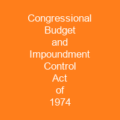The United States Budget Process: A Framework for Fiscal Control
Imagine a vast machine, cogs turning in perfect harmony to keep the nation running smoothly. This machine is the United States budget process, a complex and intricate system that ensures the government operates within its financial means. Established by the Budget and Accounting Act of 1921 and further refined by the Congressional Budget and Impoundment Control Act of 1974, this framework serves as both a guide and a challenge for those in power.
From Nixon to Formalization
Before 1974, the budget process was more like a haphazard assembly line. But when President Richard Nixon began to refuse spending funds allocated by Congress, it became clear that a formal system was needed. This led to the adoption of a more structured approach, one that would give Congress and the President equal footing in managing the nation’s finances.
Discretionary Spending: The 12 Bills
At the heart of this process lies discretionary spending, which requires an annual appropriation bill. Think of these bills as the individual parts that make up a complex machine. There are 12 such bills, each addressing different areas like defense, education, and transportation. These bills must be passed every fiscal year to ensure the government can continue its operations.
The President’s Budget Request
Every January or February, the President submits a budget request to Congress. This document is akin to a blueprint for the nation’s financial future, outlining spending and revenue proposals. The Congressional Budget Office (CBO) then steps in, providing an analysis of these proposals. It’s like having a third party review your home renovation plans before you start hammering away.
The Role of the CBO
Established in 1974, the CBO was created to gain more control over the budget and limit the power of the President’s Office of Management and Budget (OMB). Its role is crucial; it provides Congress with a balanced view of the proposed budget. The CBO’s analysis helps both chambers make informed decisions when crafting their own budget resolutions.
From Resolution to Reality
The budget resolution, passed by both houses of Congress but not requiring the President’s signature, sets out congressional budget totals and allocations. It acts as a blueprint for the appropriation process, giving Congress control over appropriations. The CBO publishes its analysis in March, and the House and Senate consider this report before submitting their own budget resolutions.
Conference Reports: Resolving Differences
Once both chambers have passed their respective budgets, Representatives and Senators negotiate a conference report to reconcile differences. This process ensures that the final budget aligns with both houses’ priorities. The budget resolution serves as a guiding light for this negotiation, providing Congress with control over appropriations.
Mandatory Spending: A Separate Category
While discretionary spending requires annual appropriation bills, mandatory spending is different. This category includes programs like Social Security and Medicare, which are funded through laws rather than annual appropriations. Most mandatory spending consists of transfer payments and earned benefits such as Social Security benefits, Medicare, and Medicaid.
The Budget Functions: A Broader View
Finally, the federal budget is divided into categories known as budget functions. These include all spending for a given topic regardless of the federal agency overseeing the individual program. The President’s budget and Congress’ budget resolution provide summaries by function, but they do not line up with the twelve appropriations bills.
Understanding the United States budget process is crucial for anyone interested in how the government operates. It’s like navigating through a maze, where every turn leads to new challenges and opportunities. The next time you hear about the federal budget, remember that it’s more than just numbers—it’s a complex system designed to keep our nation running smoothly.

By understanding the intricacies of this system, we can better appreciate how our government manages its finances and make informed decisions about what matters most. After all, every dollar spent or saved has a direct impact on our lives.
You want to know more about United States budget process?
This page is based on the article United States budget process published in Wikipedia (retrieved on February 26, 2025) and was automatically summarized using artificial intelligence.





